Effectively Controlled Structures of Si-C Composites from Rice Husk for Oxygen Evolution Catalyst
Abstract
:1. Introduction
2. Results and Discussion
3. Experimental Method
3.1. Materials
3.1.1. Preparation of Rice-Husk-Based Carbon Materials
3.1.2. Preparation of Fe3O4/Rice-Husk-Based Carbon Composites
3.2. Characterization
3.3. Electrochemical Test
4. Conclusions
Author Contributions
Funding
Institutional Review Board Statement
Informed Consent Statement
Data Availability Statement
Conflicts of Interest
Sample Availability
References
- You, M.; Du, X.; Hou, X.; Wang, Z.; Zhou, Y.; Ji, H.; Zhang, L.; Zhang, Z.; Yi, S.; Chen, D. In-situ growth of ruthenium-based nanostructure on carbon cloth for superior electrocatalytic activity towards HER and OER. Appl. Catal. B Environ. 2022, 317, 121729. [Google Scholar] [CrossRef]
- Feng, Y.; Zhao, Z.; Li, F.; Bu, L.; Shao, Q.; Li, L.; Wu, J.; Zhu, X.; Lu, G.; Huang, X. Highly Surface-Distorted Pt Superstructures for Multifunctional Electrocatalysis. Nano Lett. 2021, 21, 5075–5082. [Google Scholar]
- Paudel, D.R.; Pan, U.N.; Singh, T.I.; Gudal, C.C.; Kim, N.H.; Lee, J.H. Fe and P Doped 1T-Phase Enriched WS23D-Dendritic Nanostructures for Efficient Overall Water Splitting. Appl. Catal. B Environ. 2021, 286, 119897. [Google Scholar] [CrossRef]
- Sondermann, L.; Jiang, W.; Shviro, M.; Spieß, A.; Woschko, D.; Rademacher, L.; Janiak, C. Nickel-Based Metal-Organic Frameworks as Electrocatalysts for the Oxygen Evolution Reaction (OER). Molecules 2022, 27, 1241. [Google Scholar] [CrossRef] [PubMed]
- Li, C.; Li, T.; Yu, G.; Chen, W. Theoretical Investigation of HER and OER Electrocatalysts Based on the 2D R-graphyne Completely Composed of Anti-Aromatic Carbon Rings. Molecules 2023, 28, 3888. [Google Scholar] [CrossRef] [PubMed]
- Ejeta, S.Y.; Imae, T. Cobalt Incorporated Graphitic Carbon Nitride as a Bifunctional Catalyst for Electrochemical Water-Splitting Reactions in Acidic Media. Molecules 2022, 27, 6445. [Google Scholar] [CrossRef]
- Yan, H.; Wang, X.; Linkov, V.; Ji, S.; Wang, R. Selectivity of Oxygen Evolution Reaction on Carbon Cloth-Supported δ-MnO2 Nanosheets in Electrolysis of Real Seawater. Molecules 2023, 28, 854. [Google Scholar] [CrossRef]
- Sato, Y.; Yamada, N.; Kitano, S.; Kowalski, D.; Aoki, Y.; Habazaki, H. High-corrosion-resistance mechanism of graphitized platelet-type carbon nanofibers in the OER in a concentrated alkaline electrolyte. J. Mater. Chem. A 2022, 10, 8208–8217. [Google Scholar]
- Singh, H.; Marley-Hines, M.; Chakravarty, S.; Nath, M. Multi-walled carbon nanotube supported manganese selenide as a highly active bifunctional OER and ORR electrocatalyst. J. Mater. Chem. A 2022, 10, 6772–6784. [Google Scholar] [CrossRef]
- Hou, G.; Jia, X.; Kang, H.; Qiao, X.; Liu, Y.; Li, Y.; Wu, X.; Qin, W. CoNi nano-alloys modified yolk-shell structure carbon cage via Saccharomycetes as carbon template for efficient oxygen evolution reaction. Appl. Catal. B Environ. 2022, 315, 121551. [Google Scholar]
- Chen, W.; Xie, Y.; Gao, X.; Li, L.; Lin, Z. Simultaneous optimization of CoIr alloy nanoparticles and 2D graphitic-N doped carbon support in CoIr@CN by Ir doping for enhanced oxygen and hydrogen evolution reactions. J. Mater. Chem. A 2022, 10, 15543–15553. [Google Scholar] [CrossRef]
- Quílez-Bermejo, J.; García-Dalí, S.; Daouli, A.; Zitolo, A.; Canevesi, R.L.S.; Emo, M.; Izquierdo, M.T.; Badawi, M.; Celzard, A.; Fierro, V. Advanced Design of Metal Nanoclusters and Single Atoms Embedded in C1N1-Derived Carbon Materials for ORR, HER, and OER. Adv. Funct. Mater. 2023, 33, 2300405. [Google Scholar] [CrossRef]
- Zhang, M.; Li, H.; Chen, J.; Ma, F.-X.; Zhen, L.; Wen, Z.; Xu, C.-Y. Transition Metal (Co, Ni, Fe, Cu) Single-Atom Catalysts Anchored on 3D Nitrogen-Doped Porous Carbon Nanosheets as Efficient Oxygen Reduction Electrocatalysts for Zn–Air Battery. Small 2022, 18, 2202476. [Google Scholar] [CrossRef]
- Ma, L.; Wei, Z.; Zhao, C.; Meng, X.; Zhang, H.; Song, M.; Wang, Y.; Li, B.; Huang, X.; Xu, C.; et al. Hierarchical superhydrophilic/superaerophobic 3D porous trimetallic (Fe, Co, Ni) spinel/carbon/nickel foam for boosting oxygen evolution reaction. Appl. Catal. B Environ. 2023, 332, 122717. [Google Scholar] [CrossRef]
- Lu, L.; Zhang, Y.; Chen, Z.; Feng, F.; Teng, K.; Zhang, S.; Zhuang, J.; An, Q. Synergistic promotion of HER and OER by alloying ternary Zn-Co-Ni nanoparticles in N-doped carbon interfacial structures. Chin. J. Catal. 2022, 43, 1316–1323. [Google Scholar] [CrossRef]
- Feng, Y.; Jiang, J.; Xu, Y.; Wang, S.; An, W.; Chai, Q.; Prova, U.H.; Wang, C.; Huang, G. Biomass derived diverse carbon nanostructure for electrocatalysis, energy conversion and storage. Carbon 2023, 211, 118105. [Google Scholar]
- Zhang, X.; Han, R.; Liu, Y.; Li, H.; Shi, W.; Yan, X.; Zhao, X.; Li, Y.; Liu, B. Porous and graphitic structure optimization of biomass-based carbon materials from 0D to 3D for supercapacitors: A review. Chem. Eng. J. 2023, 460, 141607. [Google Scholar] [CrossRef]
- Queneau, Y.; Han, B. Biomass: Renewable carbon resource for chemical and energy industry. Innovation 2022, 3, 100184. [Google Scholar] [CrossRef]
- Tian, P.; Zhan, G.; Tian, J.; Tan, K.B.; Guo, M.; Han, Y.; Fu, T.; Huang, J.; Li, Q. Direct CO2 hydrogenation to light olefins over ZnZrOx mixed with hierarchically hollow SAPO-34 with rice husk as green silicon source and template. Appl. Catal. B Environ. 2022, 315, 121572. [Google Scholar] [CrossRef]
- Dafiqurrohman, H.; Safitri, K.A.; Setyawan, M.I.B.; Surjosatyo, A.; Aziz, M. Gasification of rice wastes toward green and sustainable energy production: A review. J. Clean. Prod. 2022, 366, 132926. [Google Scholar] [CrossRef]
- Lan, K.; Zhao, D. Functional Ordered Mesoporous Materials: Present and Future. Nano Lett. 2022, 22, 3177–3179. [Google Scholar] [CrossRef] [PubMed]
- Stachowicz, L.; Singh, S.K.; Wender, E.; Girshick, S.L. Synthesis of ultrafine SiC from rice hulls (husks): A plasma process. Plasma Chem. Plasma Process. 1993, 13, 447–461. [Google Scholar] [CrossRef]
- Zhao, Z.; Xie, H.; Qu, J.; Zhao, H.; Ma, Q.; Xing, P.; Song, Q.; Wang, D.; Yin, H. A Natural Transporter of Silicon and Carbon: Conversion of Rice Husks to Silicon Carbide or Carbon-Silicon Hybrid for Lithium-Ion Battery Anodes via a Molten Salt Electrolysis Approach. Batter. Supercaps 2019, 2, 1007–1015. [Google Scholar] [CrossRef]
- Qian, J.-M.; Wang, J.-P.; Qiao, G.-J.; Jin, Z.-H. Preparation of porous SiC ceramic with a woodlike microstructure by sol-gel and carbothermal reduction processing. J. Eur. Ceram. Soc. 2004, 24, 3251–3259. [Google Scholar]
- Yang, S.; Kiraly, B.; Wang, W.Y.; Shang, S.; Cao, B.; Zeng, H.; Zhao, Y.; Li, W.; Liu, Z.-K.; Cai, W.; et al. Fabrication and Characterization of Beaded SiC Quantum Rings with Anomalous Red Spectral Shift. Adv. Mater. 2012, 24, 5598–5603. [Google Scholar] [CrossRef]
- Satapathy, L.N.; Ramesh, P.D.; Agrawal, D.; Roy, R. Microwave synthesis of phase-pure, fine silicon carbide powder. Mater. Res. Bull. 2005, 40, 1871–1882. [Google Scholar] [CrossRef]
- Singh, B. 13—Rice husk ash. In Waste and Supplementary Cementitious Materials in Concrete; Siddique, R., Cachim, P., Eds.; Woodhead Publishing: Cambridge, UK, 2018; pp. 417–460. [Google Scholar]
- Li, D.; Zhang, X.; Wang, Y.; Yan, X.; Zong, P.; Lu, G.; Tian, Y. Activation of rice hull char with steam to improve lithium storage performance of SiO2/C. J. Anal. Appl. Pyrolysis 2021, 157, 105185. [Google Scholar] [CrossRef]
- Han, H.-W.; Liu, H.-S. Characterization of vapour deposited products in furnace tube during SiC synthesis from carbonized rice hulls. Ceram. Int. 1999, 25, 631–637. [Google Scholar] [CrossRef]
- Temeche, E.; Yu, M.; Laine, R.M. Silica depleted rice hull ash (SDRHA), an agricultural waste, as a high-performance hybrid lithium-ion capacitor. Green Chem. 2020, 22, 4656–4668. [Google Scholar] [CrossRef]
- Yu, M.; Temeche, E.; Indris, S.; Laine, R.M. Adjusting SiO2 : C mole ratios in rice hull ash (RHA) to control carbothermal reduction to nanostructured SiC, Si3N4 or Si2N2O composites. Green Chem. 2021, 23, 7751–7762. [Google Scholar] [CrossRef]
- Krishnarao, R.V.; Mahajan, Y.R. Formation of SiC whiskers from raw rice husks in argon atmosphere. Ceram. Int. 1996, 22, 353–358. [Google Scholar] [CrossRef]
- Alweendo, S.T.; Johnson, O.T.; Shongwe, M.B.; Kavishe, F.P.L.; Borode, J.O. Synthesis, Optimization and Characterization of Silicon Carbide (SiC) from Rice Husk. Procedia Manuf. 2019, 35, 962–967. [Google Scholar] [CrossRef]
- Nutt, S.R. Microstructure and Growth Model for Rice-Hull-Derived SiC Whiskers. J. Am. Ceram. Soc. 1988, 71, 149–156. [Google Scholar] [CrossRef]
- Niyomwas, S. Synthesis and characterization of silicon-silicon carbide composites from rice husk ash via self-propagating high temperature synthesis. J. Met. Mater. Miner. 2017, 19, 21–25. [Google Scholar]
- Li, J.; Chen, C.; Lv, Z.; Ma, W.; Wang, M.; Li, Q.; Dang, J. Constructing heterostructures of ZIF-67 derived C, N doped Co2P and Ti2VC2Tx MXene for enhanced OER. J. Mater. Sci. Technol. 2023, 145, 74–82. [Google Scholar]
- Yin, H.L.; Yang, W.; Zhao, L.C.; Hu, X.M.; Liu, S.Q.; Cui, C.X.; Wang, X. Fabrication and mechanical property of three-dimensional carbon fiber reinforced Mg-based bulk metallic glass matrix composite. Mater. Sci. Eng. A 2022, 839, 142853. [Google Scholar]
- Yin, H.L.; Liu, S.Q.; Zhao, L.C.; Cui, C.X.; Wang, X. Vacuum infiltration molding and mechanical property of short carbon fiber reinforced Ti-based metallic glass matrix composite. J. Mater. Process. Technol. 2021, 295, 117151. [Google Scholar] [CrossRef]
- Gong, S.; Sun, Y.; Zheng, K.; Jiang, G.; Li, L.; Feng, J. Degradation of levofloxacin in aqueous solution by non-thermal plasma combined with Ag3PO4/activated carbon fibers: Mechanism and degradation pathways. Sep. Purif. Technol. 2020, 250, 117264. [Google Scholar] [CrossRef]
- Jia, Y.; Sun, X.; Shi, Z.; Jiang, K.; Liu, H.; Ben, J.; Li, D. Modulating the Surface State of SiC to Control Carrier Transport in Graphene/SiC. Small 2018, 14, 1801273. [Google Scholar]
- Zhou, F.; Gan, M.; Yan, D.; Chen, X.; Peng, X. Hydrogen-Rich Pyrolysis from Ni-Fe Heterometallic Schiff Base Centrosymmetric Cluster Facilitates NiFe Alloy for Efficient OER Electrocatalysts. Small 2023, 19, 2208276. [Google Scholar] [CrossRef]
- Janghorban, K.; Tazesh, H.R. Effect of catalyst and process parameters on the production of silicon carbide from rice hulls. Ceram. Int. 1999, 25, 7–12. [Google Scholar] [CrossRef]
- Weng, W.; Wang, S.; Xiao, W.; Lou, X.W. Direct Conversion of Rice Husks to Nanostructured SiC/C for CO2 Photoreduction. Adv. Mater. 2020, 32, 2001560. [Google Scholar] [CrossRef]
- Freitas, J.C.C.; Moreira, J.S.; Emmerich, F.G.; Bonagamba, T.J. Development of Si/C/N/O ceramics from pyrolyzed and heat-treated rice hulls. J. Non-Cryst. Solids 2004, 341, 77–85. [Google Scholar] [CrossRef]
- Li, G.; Tang, Y.; Fu, T.; Xiang, Y.; Xiong, Z.; Si, Y.; Guo, C.; Jiang, Z. S, N co-doped carbon nanotubes coupled with CoFe nanoparticles as an efficient bifunctional ORR/OER electrocatalyst for rechargeable Zn-air batteries. Chem. Eng. J. 2022, 429, 132174. [Google Scholar] [CrossRef]
- Lamy-Mendes, A.; Malfait, W.J.; Sadeghpour, A.; Girão, A.V.; Silva, R.F.; Durães, L. Influence of 1D and 2D carbon nanostructures in silica-based aerogels. Carbon 2021, 180, 146–162. [Google Scholar] [CrossRef]
- Li, C.; Chen, H.; Zhang, L.; Jiao, S.; Zhang, H.; Zhang, J.; Li, P.; Tao, Y.; Zhao, X. Rice Hull-Derived Carbon for Supercapacitors: Towards Sustainable Silicon-Carbon Supercapacitors. Polymers 2021, 13, 4463. [Google Scholar] [CrossRef]
- Zhao, X.; Li, C.; Sha, L.; Yang, K.; Gao, M.; Chen, H.; Jiang, J. In-Built Fabrication of MOF Assimilated Porous Hollow Carbon from Pre-Hydrolysate for Supercapacitor. Polymers 2022, 14, 3377. [Google Scholar] [CrossRef]
- Jiao, S.; Zhang, L.; Li, C.; Zhang, H.; Zhang, J.; Li, P.; Tao, Y.; Zhao, X.; Chen, H.; Jiang, J. Efficient construction of a carbon-based symmetric supercapacitor from soybean straw by coupling multi-stage carbonization and mild activation. Ind. Crops Prod. 2022, 183, 114906. [Google Scholar]
- Wang, B.; Ye, Y.; Xu, L.; Quan, Y.; Wei, W.; Zhu, W.; Li, H.; Xia, J. Space-Confined Yolk-Shell Construction of Fe3O4 Nanoparticles Inside N-Doped Hollow Mesoporous Carbon Spheres as Bifunctional Electrocatalysts for Long-Term Rechargeable Zinc–Air Batteries. Adv. Funct. Mater. 2020, 30, 2005834. [Google Scholar]
- Bianchetti, E.; Perilli, D.; Di Valentin, C. Improving the Oxygen Evolution Reaction on Fe3O4(001) with Single-Atom Catalysts. ACS Catal. 2023, 13, 4811–4823. [Google Scholar] [CrossRef]
- Xu, W.; Zhong, W.; Yang, C.; Zhao, R.; Wu, J.; Li, X.; Yang, N. Tailoring interfacial electron redistribution of Ni/Fe3O4 electrocatalysts for superior overall water splitting. J. Energy Chem. 2022, 73, 330–338. [Google Scholar] [CrossRef]
- Huang, W.; Peng, C.; Tang, J.; Diao, F.; Nulati Yesibolati, M.; Sun, H.; Engelbrekt, C.; Zhang, J.; Xiao, X.; Mølhave, K.S. Electronic structure modulation with ultrafine Fe3O4 nanoparticles on 2D Ni-based metal-organic framework layers for enhanced oxygen evolution reaction. J. Energy Chem. 2022, 65, 78–88. [Google Scholar] [CrossRef]
- Royer, L.; Bonnefont, A.; Asset, T.; Rotonnelli, B.; Velasco-Vélez, J.-J.; Holdcroft, S.; Hettler, S.; Arenal, R.; Pichon, B.; Savinova, E. Cooperative Redox Transitions Drive Electrocatalysis of the Oxygen Evolution Reaction on Cobalt–Iron Core–Shell Nanoparticles. ACS Catal. 2023, 13, 280–286. [Google Scholar] [CrossRef]
- Liu, H.-J.; Zhang, S.; Zhou, Y.-N.; Yu, W.-L.; Ma, Y.; Wang, S.-T.; Chai, Y.-M.; Dong, B. Dynamically Stabilized Electronic Regulation and Electrochemical Reconstruction in Co and S Atomic Pair Doped Fe3O4 for Water Oxidation. Small 2023, 2301255. [Google Scholar] [CrossRef]
- Luo, H.; Zhao, X.; Zhang, T.; Si, R.; Gong, X.; Li, C.; Kong, F.; Liu, Y.; Jiang, J.; Chen, H. Self-supporting porous wood-based carbon with metal-organic framework derived metal bridges for effectively electrocatalytic hydrogen evolution at large current density. Int. J. Hydrogen Energy 2023, 48, 9244–9259. [Google Scholar] [CrossRef]
- Liu, G.; Wang, B.; Ding, P.; Ye, Y.; Wei, W.; Zhu, W.; Xu, L.; Xia, J.; Li, H. Reactable ionic liquid in situ-induced synthesis of Fe3O4 nanoparticles modified N-doped hollow porous carbon microtubes for boosting multifunctional electrocatalytic activity. J. Alloys Compd. 2019, 797, 849–858. [Google Scholar] [CrossRef]
- Gan, L.; Fang, J.; Wang, M.; Hu, L.; Zhang, K.; Lai, Y.; Li, J. Preparation of double-shell Co9S8/Fe3O4 embedded in S/N co-decorated hollow carbon nanoellipsoid derived from Bi-Metal organic frameworks for oxygen evolution reaction. J. Power Sources 2018, 391, 59–66. [Google Scholar] [CrossRef]
- Luo, Y.; Yang, H.; Ma, P.; Luo, S.; Zhao, Z.; Ma, J. Fe3O4/CoO Interfacial Nanostructure Supported on Carbon Nanotubes as a Highly Efficient Electrocatalyst for Oxygen Evolution Reaction. ACS Sustain. Chem. Eng. 2020, 8, 3336–3346. [Google Scholar] [CrossRef]

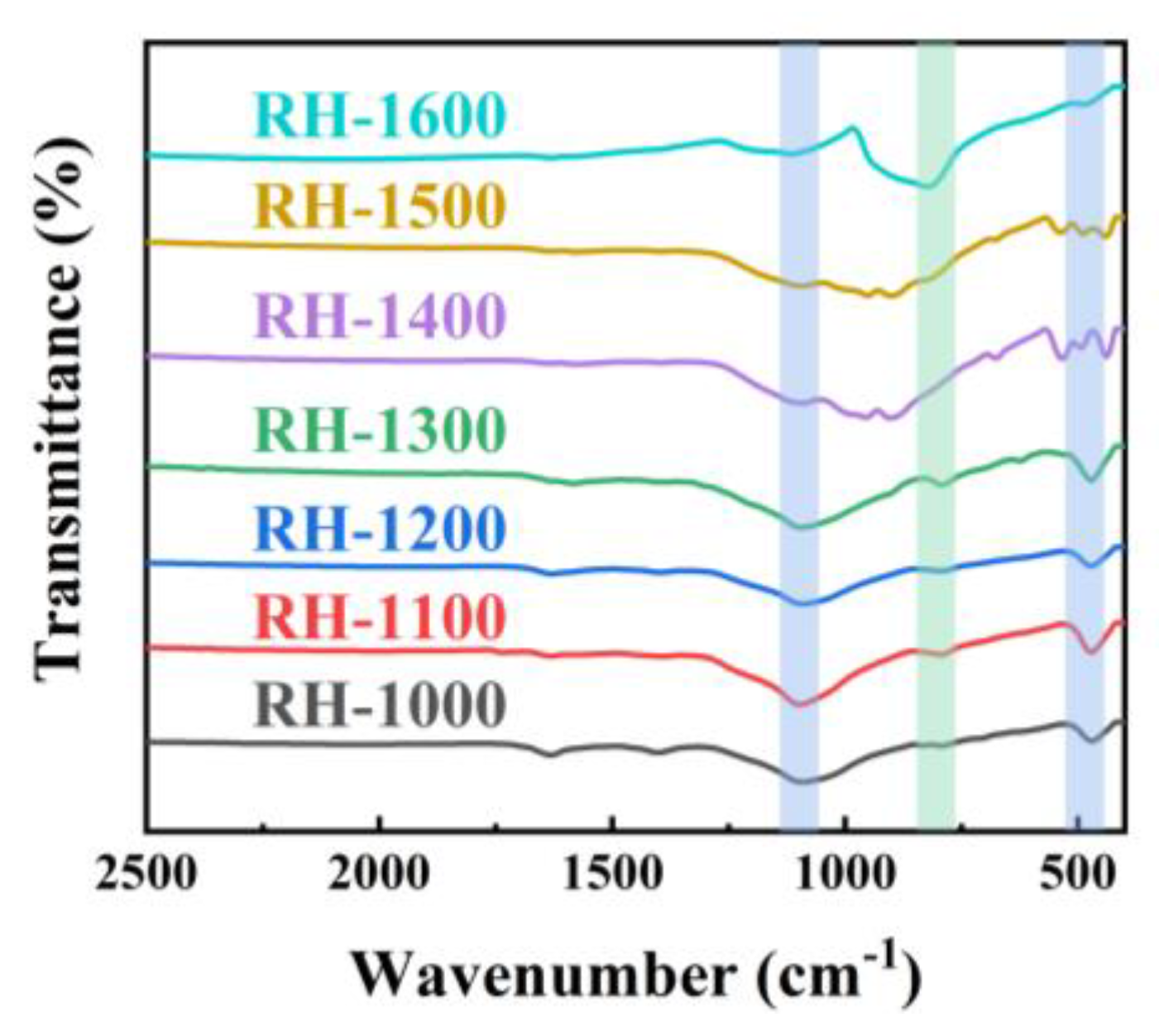


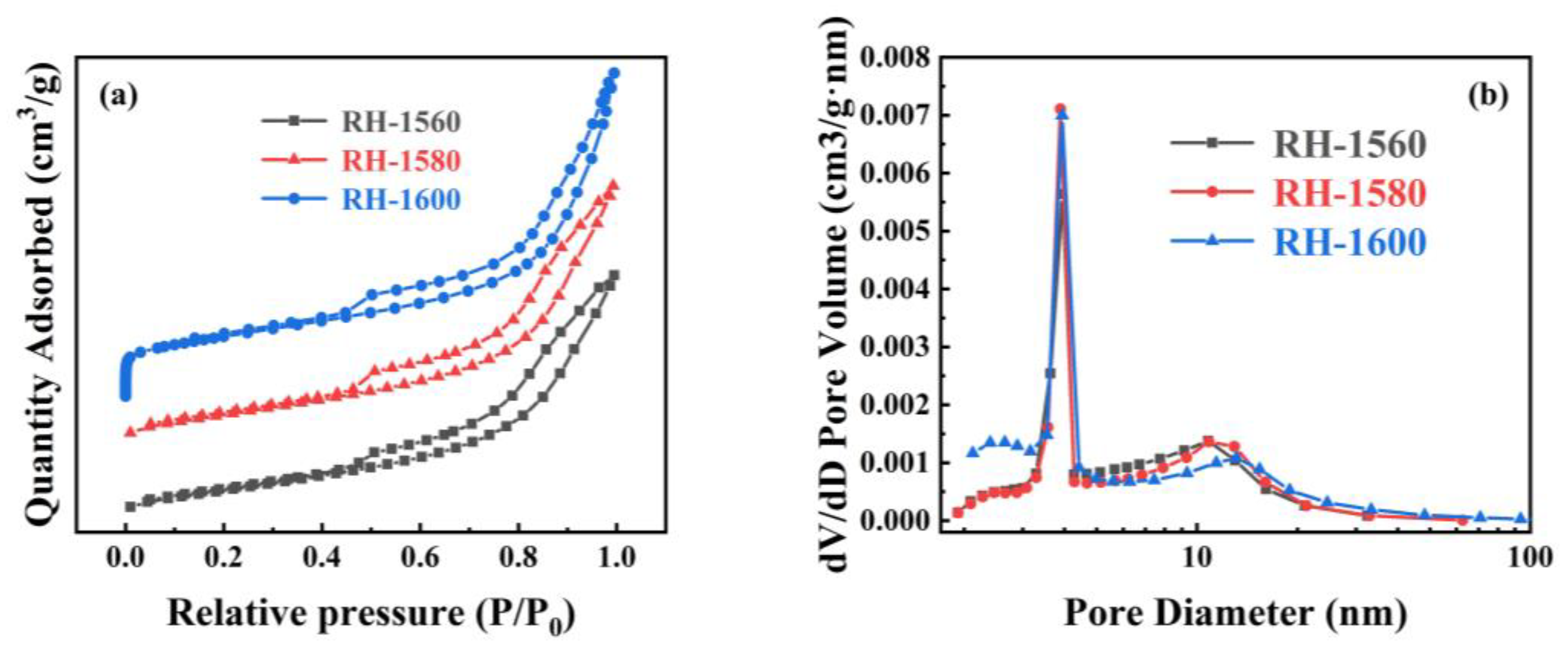

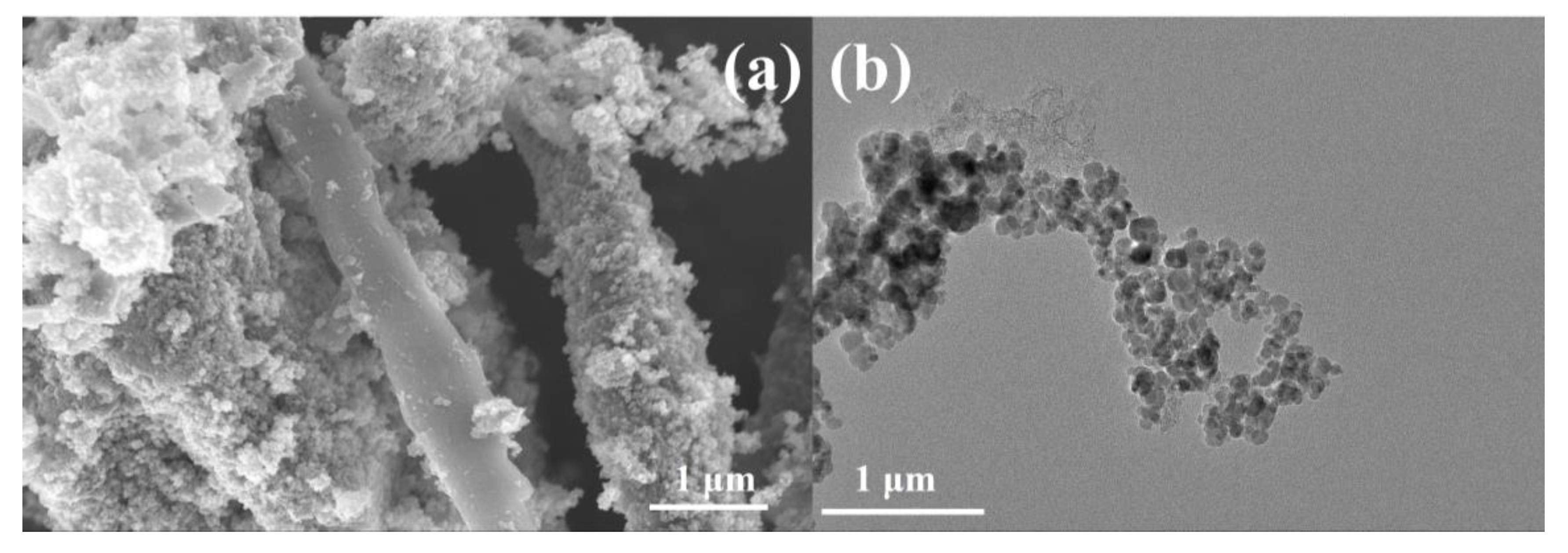

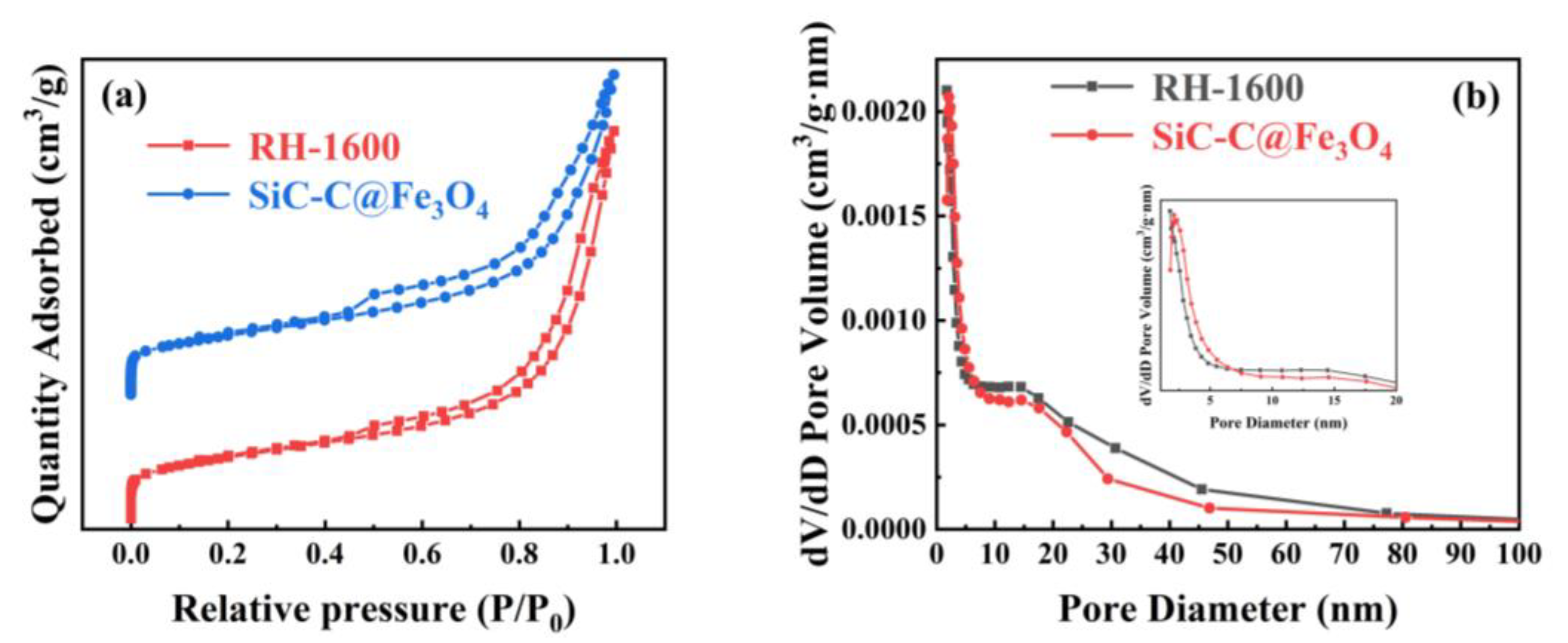

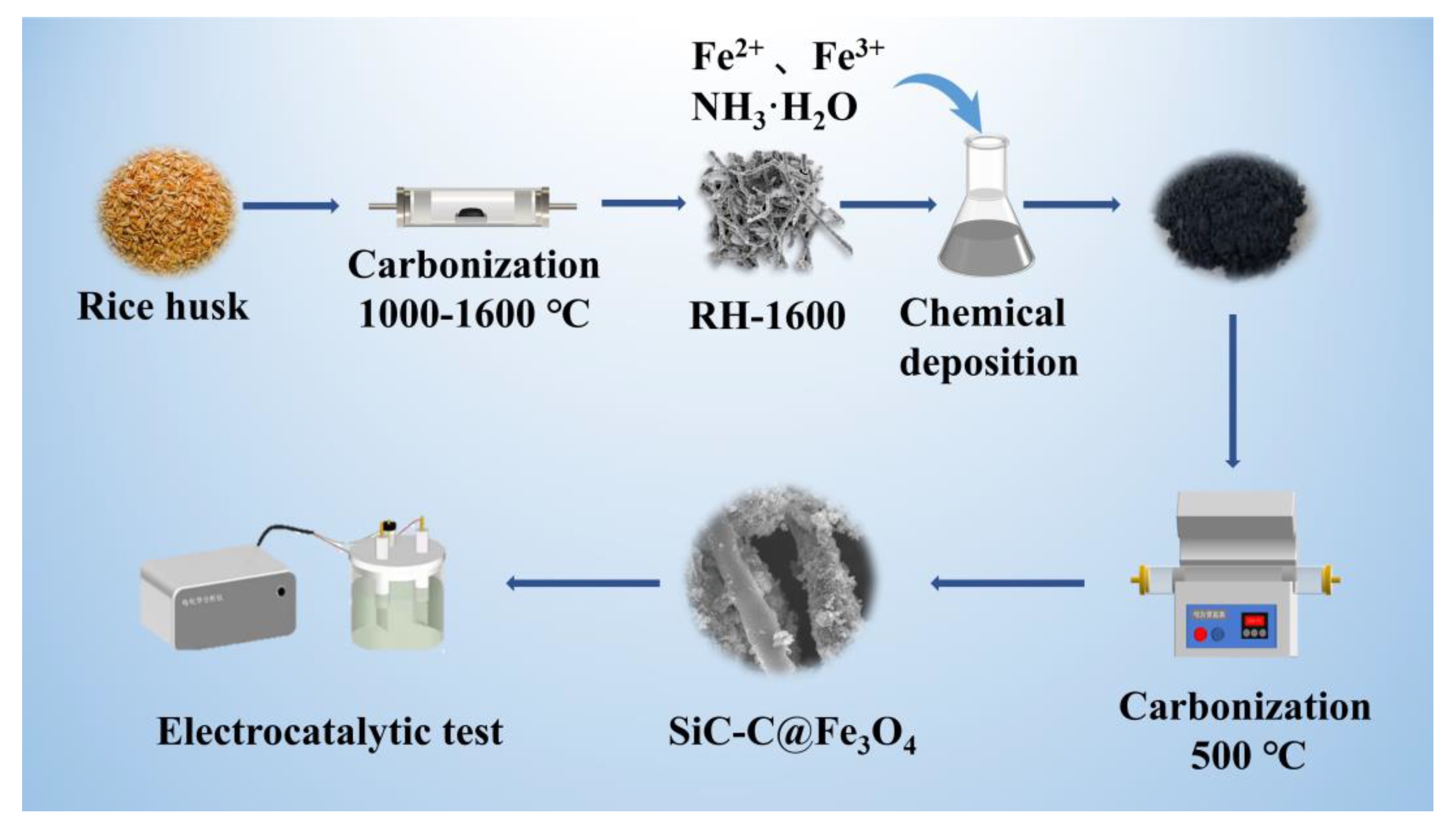
| Sample | SBET (m2 g−1) | Smeso/SBET (%) | Pore Volume (cm3 g−1) | Average Pore Size (nm) |
|---|---|---|---|---|
| RH-1560 | 100.2 | 91.3 | 0.191 | 8.2 |
| RH-1580 | 107.4 | 88.9 | 0.205 | 8.7 |
| RH-1600 | 121.9 | 83.5 | 0.278 | 9.1 |
| Sample | SBET (m2 g−1) | Smeso/SBET (%) | Pore Volume (cm3 g−1) | Average Pore Size (nm) |
|---|---|---|---|---|
| RH-1600 | 121.9 | 83.5 | 0.278 | 9.1 |
| SiC-C@Fe3O4 | 125.5 | 83.6 | 0.327 | 10.4 |
| Material | Electrolyte | Current Density (mA cm−2) | Overpotential (mV) | Tafel Slope (mV dec−1) | Reference |
|---|---|---|---|---|---|
| Fe3O4/NCMTs-800(IL) | 1.0 M KOH | 10 | 310 | 80.81 | [57] |
| Fe20@N/HCSs | 1.0 M KOH | 10 | 289 | 52.4 | [50] |
| H-Co9S8/ Fe3O4@SNC | 0.1 M KOH | 10 | 280 | 87 | [58] |
| Fe3O4/CoO CNTs | 1.0 M KOH | 10 | 270 | 59 | [59] |
| SiC-C@Fe3O4 | 1.0 M KOH | 10 | 260 | 56.93 | Present study |
Disclaimer/Publisher’s Note: The statements, opinions and data contained in all publications are solely those of the individual author(s) and contributor(s) and not of MDPI and/or the editor(s). MDPI and/or the editor(s) disclaim responsibility for any injury to people or property resulting from any ideas, methods, instructions or products referred to in the content. |
© 2023 by the authors. Licensee MDPI, Basel, Switzerland. This article is an open access article distributed under the terms and conditions of the Creative Commons Attribution (CC BY) license (https://creativecommons.org/licenses/by/4.0/).
Share and Cite
Li, C.; Zhao, X.; Gao, M.; Kong, F.; Chen, H. Effectively Controlled Structures of Si-C Composites from Rice Husk for Oxygen Evolution Catalyst. Molecules 2023, 28, 6117. https://doi.org/10.3390/molecules28166117
Li C, Zhao X, Gao M, Kong F, Chen H. Effectively Controlled Structures of Si-C Composites from Rice Husk for Oxygen Evolution Catalyst. Molecules. 2023; 28(16):6117. https://doi.org/10.3390/molecules28166117
Chicago/Turabian StyleLi, Changwei, Xin Zhao, Min Gao, Fangong Kong, and Honglei Chen. 2023. "Effectively Controlled Structures of Si-C Composites from Rice Husk for Oxygen Evolution Catalyst" Molecules 28, no. 16: 6117. https://doi.org/10.3390/molecules28166117
APA StyleLi, C., Zhao, X., Gao, M., Kong, F., & Chen, H. (2023). Effectively Controlled Structures of Si-C Composites from Rice Husk for Oxygen Evolution Catalyst. Molecules, 28(16), 6117. https://doi.org/10.3390/molecules28166117






